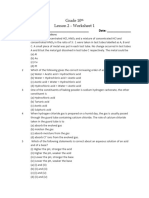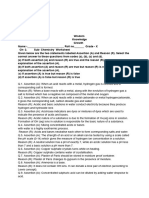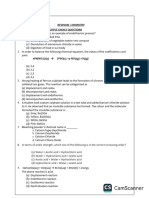Cambridge School, Noida CLASS - X (2021-22) Acid, Bases and Salts
Cambridge School, Noida CLASS - X (2021-22) Acid, Bases and Salts
Uploaded by
Aman ChoudharyCopyright:
Available Formats
Cambridge School, Noida CLASS - X (2021-22) Acid, Bases and Salts
Cambridge School, Noida CLASS - X (2021-22) Acid, Bases and Salts
Uploaded by
Aman ChoudharyOriginal Description:
Original Title
Copyright
Available Formats
Share this document
Did you find this document useful?
Is this content inappropriate?
Copyright:
Available Formats
Cambridge School, Noida CLASS - X (2021-22) Acid, Bases and Salts
Cambridge School, Noida CLASS - X (2021-22) Acid, Bases and Salts
Uploaded by
Aman ChoudharyCopyright:
Available Formats
CAMBRIDGE SCHOOL,NOIDA
CLASS – X(2021-22)
ACID,BASES AND SALTS
~ANSHIKA CHOUDHARY (X-C)
MULTIPLE CHOICE QUESTIONS:-
1. Which one of the following is acidic?
(a) Lemon juice (b) Tomatoes (c) Milk (d) All
2. Which one of the following will turn red litmus blue?
(a) Vinegar (b) Baking soda solution (c) Lemon juice (d) Soft drinks
3. Which one of the following will turn blue litmus red?
(a) Vinegar (b) Lime water (c) Baking soda solution (d) Washing soda solution
4. Methyl orange is
(a)Pink in acidic medium, yellow in basic medium
(b)Yellow in acidic medium, pink in basic medium
(c) Colourless in acidic medium, pink in basic medium
(d) Pink in acidic medium, colourless in basic medium.
5. Lime water is
(a) CaO (b) Ca(OH)2 (c) CaCO3 (d) CaCl2
6. The nature of calcium phosphate is present in tooth enamel is
(a) Basic (b) Amphoteric (c) Acidic (d) Neutral
7. Which of the following salts has no water of crystallization?
(a) Blue vitriol (b) Washing soda (c) Baking soda (d) Gypsum
8. The function of quick lime in soda lime mixture is to
(a) Absorb moisture present in soda lime
(b) Increase the efficiency of soda lime
(c) Increase the pH of soda lime
(d) Take part in reaction with NaOH
9. The difference of molecules of water in gypsum and POP is
(a) 5/2 (b) 1 (c) 3/2 (d) ½
10. The chemical formula of caustic potash is
(a) NaOH (b) Ca(OH)2 (c) NH4OH (D) KOH
11. NaOH solution turns phenolphthalein solution:-
(a) Pink (b) Colourless (c) Orange (d) Yellow
12. Tooth enamel is made up of:-
(a) Calcium carbonate (b) Calcium phosphate (c) Calcium hydroxide (d) Potassium
13. Alkalis are:-
(a) Acids,which are soluble in water
(b) Acids,which are insoluble in water
(c ) Bases,which are soluble in water
(d) Bases ,which are insoluble in water
14. Brine is an:-
(a) Aqueous solution of sodium hydroxide
(b) Aqueous solution of sodium carbonate
(c) Aqueous solution of sodium bicarbonate
(d) Aqueous solution of sodium chloride
15. Which of the following salt contains water of crystallization:-
(a) Sodium chloride (b) Baking soda (c) Gypsum (d) Limestone
16. In terms of acidic strength, which of the following is in the correct increasing order:-
(a) Water <Acetic acid< Hydrochloric acid
(b) Water <Hydrochloric acid <Acetic acid
(c) Acetic acid< Water <Hydrochloric acid
(d) Hydrochloric acid <Water <Acetic acid
17. Tomato is the natural source of:-
(a) Acetic acid (b) Tartaric acid (c) Oxalic acid (d) Citric acid
18. Sodium carbonate is a basic salt because:-
(a) strong acid and strong base
(b) weak acid and weak base
(c) Strong acid and weak base
(d) Weak acid and strong base
19. Which of the following are present in a dilute aqueous solution of hydrochloric acid:-
(a) H3O+ and Cl-
(b) H3O+ and OH-
(c) Cl- and OH-
(d) Unionised HCl
20. Acetic acid was added to solid X kept in a test tube and a colourless and odourless gas was evolved.The gas was passed through lime water which turned
milky .It was concluded that:-
(a) Solid X is sodium hydroxide and gas evolved is CO2.
(b)Solid X is sodium bicarbonate and gas evolved is CO2.
(c)Solid X is sodium acetate and gas evolved is CO2.
ASSERTION AND REASONING QUESTIONS(21-31)
In the following question, a statement of assertion is given by the corresponding statement of reason. Mark the correct answer .
(a) if both assertion and reason are true and reason is the correct explanation of assertion (b) if both assertion and reason are true but reason is not the correct
explanation of assertion (c) if assertion is true, but reason is false (d) if assertion is false, but reason is true (e) if assertion and reason are both false
21. ASSERTION: Carbonic acid is a weak acid.
REASON: It ionizes completely in aqueous solution.
Answer : (c) if assertion is true, but reason is false
22. ASSERTION: Bleaching powder liberates chlorine gas when kept in atmosphere.
REASON: CaOCl2 reacts with CO2 present in atmosphere to form CaCO3 and Cl2 gas.
Answer : if both assertion and reason are true but reason is not the correct explanation of assertion
23. ASSERTION: Universal indicator gives green colour with distilled water.
REASON: pH of distilled water is 7 and it is neutral and neutral solutions give green colour with universal indicator.
Answer : if both assertion and reason are trueand reason is the correct explanation of assertion
24. ASSERTION: While dissolving an acid in water,the acid must be added slowly to water with constant stirring.
REASON: Dissolving an acid in water is an exothermic reaction
Answer : if both assertion and reason are trueand reason is the correct explanation of assertion
25. ASSERTION: Phenophthalein gives pink colur in basic solution.
REASON: Phenolphthalein is a natural indicator.
Answer : (c) if assertion is true, but reason is false
26. ASSERTION: Dry HCl gas does not change the colour of dry blue litmus paper.
REASON: HCl gas dissolves in water present in the wet litmus paper to give H+ ions.
Answer : if both assertion and reason are trueand reason is the correct explanation of assertion
27. ASSERTION: Baking soda creates acidity in the stomach.
REASON: Baking soda is alkaline in nature.
Answer : assertion is false, but reason is true
29 ASSERTION: During electrolysis of concentrated aqueous solution of sodium chloride,hydrogen gas is produced at anode and chlorine gas is produced at
cathode.
REASON: Ions get attracted to oppositely charged electrodes.
Answer : assertion is false, but reason is true
30.ASSERTION: The aqueous solution of glucose and alcohol do not show acidic character.
REASON: Aqueous solution of glucose and alcohol do not give H+ ions.
Answer : a) Both A and R are true and R is the correct explanation of the assertion
31. ASSERTION: Plaster of paris is used by doctors for setting fractured bones.
REASON: When plaster of paris is mixed with water and applied around fractured limbs, it sets into a hard mass.
Answer : a) Both A and R are true and R is the correct explanation of the assertion
32. MATCH THE FOLLOWING:-
A.Bleaching powder (i) Preparation of glass
B..Plaster of Paris (ii) Production of H2 and Cl2
C..Washing soda (iii) Used by doctors
D. Baking Soda (iv) Antacid
E.Sodium chloride (v) Decolourisation
Answers:
(A) –(v) Decolourisation
B) (iii) Used by doctors
C) (i) Preparation of glass
D) (iv) Antacid
E) ii) Production of H2 and Cl2
You might also like
- ACP Acid Base and SaltsDocument13 pagesACP Acid Base and SaltsLochan. C.NNo ratings yet
- Ch-2Document6 pagesCh-2geetasatyapriyaNo ratings yet
- ACP (Solution) AcidBaseandSalts 16303 16301926755Document23 pagesACP (Solution) AcidBaseandSalts 16303 16301926755Anil DhariwalNo ratings yet
- 10 ChemistryDocument33 pages10 ChemistryRidhima GroverNo ratings yet
- Chemistry Chapter 2 -QuestionsDocument47 pagesChemistry Chapter 2 -QuestionsSarah CortexNo ratings yet
- Acids, Bases and Salts Worksheet.Document6 pagesAcids, Bases and Salts Worksheet.nidhirai1979No ratings yet
- Acids, Bases and Salts.Document10 pagesAcids, Bases and Salts.Vivek Earnest NathNo ratings yet
- CH 2Document12 pagesCH 2ojha.ramNo ratings yet
- Cl-10 QB Le-2Document10 pagesCl-10 QB Le-2saicharanghantasala64No ratings yet
- Chapter 2 AssignmentDocument4 pagesChapter 2 Assignmentvarexblitz7No ratings yet
- CBSE MCQsDocument57 pagesCBSE MCQsfactsworldwide07No ratings yet
- 6 YOKDL3 KQs 74 Wi Iaze 6 GDocument17 pages6 YOKDL3 KQs 74 Wi Iaze 6 GRudra PatelNo ratings yet
- ch2 Sci MCQ Padh LeDocument8 pagesch2 Sci MCQ Padh LeAryaman MalhotraNo ratings yet
- Class X Science Notes Chapter 2 Acids, Bases and SaltsDocument35 pagesClass X Science Notes Chapter 2 Acids, Bases and SaltsArtham ResourcesNo ratings yet
- Chem C H 2 WorksheetDocument4 pagesChem C H 2 Worksheetchoudharygaurav1313No ratings yet
- Learncbse - in-mCQ Questions For Class 10 Science Acids Bases and Salts With AnswersDocument8 pagesLearncbse - in-mCQ Questions For Class 10 Science Acids Bases and Salts With Answers09whitedevil90No ratings yet
- Test Paper On Acids Base and Salt 2021 by Vijay SirDocument2 pagesTest Paper On Acids Base and Salt 2021 by Vijay SirCareer 1stNo ratings yet
- Worksheet - Acids Bases and Salts - C-XDocument3 pagesWorksheet - Acids Bases and Salts - C-Xpratishtha MishraNo ratings yet
- Science Class X Chapter 02 Acids Bases and Salts Practice Paper 04 2024Document5 pagesScience Class X Chapter 02 Acids Bases and Salts Practice Paper 04 2024meghaNo ratings yet
- NCERT Exemplar Solution Class 10 Science Chapter 2Document17 pagesNCERT Exemplar Solution Class 10 Science Chapter 2mahira sachdevNo ratings yet
- Jyothish Kumar Took Sulphur Powder On A Spatula and Heated It. HeDocument9 pagesJyothish Kumar Took Sulphur Powder On A Spatula and Heated It. HeSharan SiuuNo ratings yet
- Acids, Bases and Salts MCQDocument16 pagesAcids, Bases and Salts MCQprayas thakreNo ratings yet
- Biyani's Super 30: CBSE - 10 Weekly Test Marks: 20Document3 pagesBiyani's Super 30: CBSE - 10 Weekly Test Marks: 20akhandbharat556No ratings yet
- Science Class X Chapter 02 Acids Bases and Salts Practice Paper 04 2024 AnswersDocument7 pagesScience Class X Chapter 02 Acids Bases and Salts Practice Paper 04 2024 Answersdevendrapatil6jNo ratings yet
- Acids Bases WS 1689573034Document6 pagesAcids Bases WS 1689573034shreyasNo ratings yet
- Grade X MCQ WORKSHEET (Peer Assessment) Time 25Document3 pagesGrade X MCQ WORKSHEET (Peer Assessment) Time 25Anvi MantriNo ratings yet
- DPP - Acid, Base and Salts (Prashant Kirad)Document10 pagesDPP - Acid, Base and Salts (Prashant Kirad)Abhinav Singh0% (1)
- Acids Bases & Salts Test Paper 02Document5 pagesAcids Bases & Salts Test Paper 02SunkaraVenkataramanaNo ratings yet
- 10TH Cbse Chemistry Ques With AnsDocument11 pages10TH Cbse Chemistry Ques With AnsdrrubberproductsNo ratings yet
- Test - Acids, Bases Ans SaltsDocument1 pageTest - Acids, Bases Ans SaltsAmmar YasirNo ratings yet
- Extra Questions Class 10 Chap 2 (Sheet 1)Document2 pagesExtra Questions Class 10 Chap 2 (Sheet 1)47hr96m9d8No ratings yet
- Acids TestDocument34 pagesAcids TestskandhaNo ratings yet
- Acids Bases and SaltsDocument12 pagesAcids Bases and SaltsPrerna JainNo ratings yet
- Acid Bases and Salts Question BankDocument4 pagesAcid Bases and Salts Question BankdhruvNo ratings yet
- Class X Question Bank Science CH 2Document14 pagesClass X Question Bank Science CH 2skj821044No ratings yet
- NCERT Class 10 Science Acids, Bases and Salts Questions PDFDocument9 pagesNCERT Class 10 Science Acids, Bases and Salts Questions PDFgomathi_nellai0% (1)
- QB Chap 2 DownloadDocument9 pagesQB Chap 2 DownloadSaravanna . B. K 8 C VVPNo ratings yet
- AcidDocument7 pagesAcidmmehnaaaNo ratings yet
- Class 10 Worksheet Ch 2Document4 pagesClass 10 Worksheet Ch 2mayank.thps.133No ratings yet
- CH-2-Acids, Bases & SaltsDocument4 pagesCH-2-Acids, Bases & Saltsaakansha8440No ratings yet
- X - CH 2-Acids Bases and SaltsDocument22 pagesX - CH 2-Acids Bases and SaltsMathanNo ratings yet
- Acids and Bases QuestionsDocument5 pagesAcids and Bases Questionsvamsi01234No ratings yet
- Class 10 Chemistry Ch. 2 HOTS 2023 - 2024Document4 pagesClass 10 Chemistry Ch. 2 HOTS 2023 - 2024Kavya ShahNo ratings yet
- Important Questions For CBSE Class 10 Science Chapter 2Document32 pagesImportant Questions For CBSE Class 10 Science Chapter 2Shaurya 5116jNo ratings yet
- Acids & Bases WsDocument5 pagesAcids & Bases WsishvaryaNo ratings yet
- Acids Bases MCQDocument8 pagesAcids Bases MCQRaahul B SNo ratings yet
- 01 Thermal PhysicsDocument5 pages01 Thermal PhysicsNikunj JSNo ratings yet
- MCQ Questions For Class 10 Science Acids Bases and Salts With Answers - Learn CBDocument19 pagesMCQ Questions For Class 10 Science Acids Bases and Salts With Answers - Learn CBMaana Ajmera100% (1)
- Assignment-2 - Acid BaseDocument6 pagesAssignment-2 - Acid BaseJayadevi ShanmugamNo ratings yet
- chapter 2 ( acids , base ,salt)Document24 pageschapter 2 ( acids , base ,salt)popupyoyo36No ratings yet
- Acids, Bases and Salts - MCQDocument7 pagesAcids, Bases and Salts - MCQMinuteBrain LearningNo ratings yet
- ChemistryDocument3 pagesChemistryAditya ArvindNo ratings yet
- Class 10 Science chemistryDocument11 pagesClass 10 Science chemistrySiddharth KumarNo ratings yet
- Previous Year Questions With Solutions - Acids, Bases and Salts - 2 - Chemistry For Class 10 PDF DownloadDocument10 pagesPrevious Year Questions With Solutions - Acids, Bases and Salts - 2 - Chemistry For Class 10 PDF DownloadMenaka SrinivasanNo ratings yet
- Acids, Bases and Salts MCQS: (D) (Ii) and (Iv)Document12 pagesAcids, Bases and Salts MCQS: (D) (Ii) and (Iv)Atharva BhokareNo ratings yet
- Quiz Abs-2Document5 pagesQuiz Abs-2rishikashrivastav0203No ratings yet
- Acids Bases and SaltsDocument5 pagesAcids Bases and Saltsbratajeet.ghosh.14No ratings yet
- 50 + Objective Type Questiosn Chapter - 2 Acid Bases & Salts Class 10 ScienceDocument11 pages50 + Objective Type Questiosn Chapter - 2 Acid Bases & Salts Class 10 ScienceTanviNo ratings yet
- Chapter 2 Acids Bases and SaltsDocument6 pagesChapter 2 Acids Bases and Saltsforstudypurpose32No ratings yet
- Multicomponent Synthesis of Pyrano (2,3-c) Pyrazole Derivative by Phosphoric Acid Functionalized Graphene Oxide As CatalystDocument8 pagesMulticomponent Synthesis of Pyrano (2,3-c) Pyrazole Derivative by Phosphoric Acid Functionalized Graphene Oxide As CatalystYaqeen Alhaqq F. GhaziNo ratings yet
- Chem Lab Report Lab 5Document11 pagesChem Lab Report Lab 5Trần Anh Huy VũNo ratings yet
- 14.0 Introduction To Organic ChemistryDocument17 pages14.0 Introduction To Organic ChemistrygoverotaropafadzwaNo ratings yet
- SBCOC by Bharat Panchal Class 11Document13 pagesSBCOC by Bharat Panchal Class 11kumarNo ratings yet
- SSC CGL T1 2024 General Awareness (English)Document127 pagesSSC CGL T1 2024 General Awareness (English)Sonu kumarNo ratings yet
- Chapter 2. Introduction To Organic Chemistry: 2.1 Functional Group and Homologous SeriesDocument8 pagesChapter 2. Introduction To Organic Chemistry: 2.1 Functional Group and Homologous SeriesDavid PhilipNo ratings yet
- Dye - Penetrant-USAF-Tech-Manual-NRDocument128 pagesDye - Penetrant-USAF-Tech-Manual-NRCesar LopezNo ratings yet
- 5 Electrochemistry WS - 1Document13 pages5 Electrochemistry WS - 1Prakriti DhakalNo ratings yet
- SIM Biochemistry ULO8Document34 pagesSIM Biochemistry ULO8Darl MalazarteNo ratings yet
- Selina Concise Chemistry Solutions Class 6 Chapter 4 Elements, Compounds, Symbols and FormulaeDocument31 pagesSelina Concise Chemistry Solutions Class 6 Chapter 4 Elements, Compounds, Symbols and FormulaeFLANTAMOCKNo ratings yet
- As Level Chemistry Practical Paper 3 GCE GuideDocument8 pagesAs Level Chemistry Practical Paper 3 GCE GuideEman Ijaz SpeaksNo ratings yet
- 2020 BGCSE ChemistryDocument12 pages2020 BGCSE ChemistrylaoneramatsabanaNo ratings yet
- Phosphate HideoutDocument3 pagesPhosphate HideoutGreater Potential Tutoring100% (1)
- 10.1515 - Gps 2021 0036Document13 pages10.1515 - Gps 2021 0036Misti DasNo ratings yet
- Grade 6 Mid TermDocument4 pagesGrade 6 Mid Termjelani17fNo ratings yet
- Chemistry CBSE XII 2015Document13 pagesChemistry CBSE XII 2015Balachandri KGINSNo ratings yet
- 358 سؤال وجواب في علم الصخور والجيوكيمياء والاستشعار عن بعدDocument164 pages358 سؤال وجواب في علم الصخور والجيوكيمياء والاستشعار عن بعدMubarak HussainNo ratings yet
- Engineering ChemistryDocument64 pagesEngineering ChemistryPRABHANJANNo ratings yet
- Cell Structure 2021-22 by Mr. Adeel AhmadDocument48 pagesCell Structure 2021-22 by Mr. Adeel AhmadADEEL AHMADNo ratings yet
- BiomoleculesDocument27 pagesBiomoleculesStarsNo ratings yet
- Biological Molecules Notes o LevelDocument10 pagesBiological Molecules Notes o LevelFangsNo ratings yet
- GenChem2 - Q4 - M1 - Spontaneous Change Entropy and Free EnergyDocument6 pagesGenChem2 - Q4 - M1 - Spontaneous Change Entropy and Free EnergyАртем МонтерейNo ratings yet
- Aula 5Document27 pagesAula 5martamonteiro13.mmNo ratings yet
- 10 ICSE Chemistry Give ReasonDocument29 pages10 ICSE Chemistry Give Reasonmridulkantpathak127No ratings yet
- Stoichiometry and The Mole Concept NotesDocument26 pagesStoichiometry and The Mole Concept Noteshafizhapni93% (30)
- Blocked Isocyanates and Their Usage in Plastic Coatings ApDocument5 pagesBlocked Isocyanates and Their Usage in Plastic Coatings ApalpersakirmetinNo ratings yet
- Casting Defects 6Document36 pagesCasting Defects 6AnuskaNo ratings yet
- (Ebook PDF) Hole's Human Anatomy & Physiology 14th Edition 2024 Scribd DownloadDocument49 pages(Ebook PDF) Hole's Human Anatomy & Physiology 14th Edition 2024 Scribd Downloadmayetojhaye100% (2)
- Removal of Ammonia by OzoneDocument9 pagesRemoval of Ammonia by OzoneMohamed AbdelhadyNo ratings yet
- Iringa Chem 2aDocument2 pagesIringa Chem 2aClemence Bukuku100% (1)

























































































